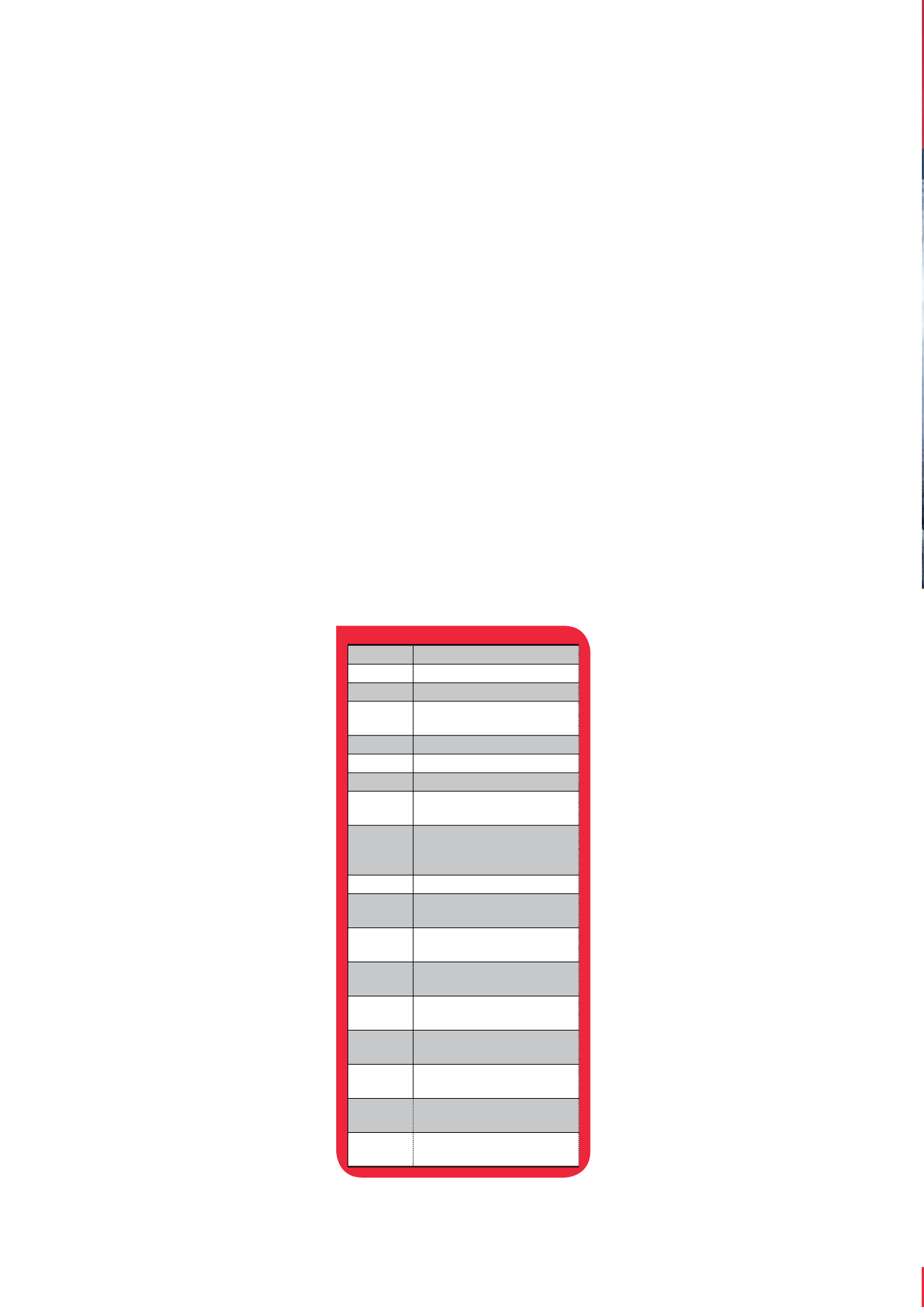
Key
ILI
Inline inspection
DA
Direct assesment
MOP
Maximum operating pressure
MIC
Microbiologically influenced
corrosion
CP
Cathodic protection
MFL
Magnetic flux leakage
UT
Ultrasonic testing
ECDA External corrosion direct
assessment
ECCDA External corrosion
confirmatory direct
assessment
IDCA Internal corrosion assessment
SCCDA Stress corrosion cracking
direct assessment
WG-ICDA Wet gas internal corrosion
direct assessment
DG-ICDA Dry gas internal corrosion
direct assessment
LP-ICDA Liquid petroleum internal
corrosion direct assessment
CP CIPS Cathodic protection close
interval potential survey
DCVG Direct current voltage
gradient
ACVG Alternating current voltage
gradient
ACCA
Alternating current-current
accentuation
Hydrotesting
Hydrotesting became common practice for pipelines in the
1940s. The process involves taking the pipeline out of service
and purging the product, then the pipeline is pressurised
above the maximum operating pressure (MOP) with the intent
to determine the ability to operate the pipeline at MOP.
While hydrotesting is still widely used today, there are several
drawbacks to the process. The water used in hydrotesting
is considered hazardous material after being used, meaning
owners incur the additional risk and cost associated with
disposing of the water after testing. The information gained
from the test is also limited in that it provides no information
of the actual condition of the pipe, coating or surrounding
environment.
Hydrotesting can also promote internal corrosion of
pipelines, especially if the water used is not properly treated
for microbiologically influenced corrosion (MIC) and chlorides.
Internal corrosion usually occurs if the pipeline is not
properly cleaned and dried after the test. Hydrotesting can
also result in pressure reversals, which worsen the integrity
of the pipeline.
1
Finally, the pipeline may be required to be
out of service for a significant amount of time, resulting in a
significant loss of revenue.
ILI tools
ILI tools – which are commonly referred to as smart pigs
– were developed in the 1960s and
commercialised in the 1970s. These tools
are designed to survey the conditions
of the pipeline wall with limited
disruption and can identify and quantify
the corrosion and cracking in steel
pipelines.
2
Magnetic flux leakage (MFL)
and ultrasonic testing (UT) are common
ILI tools used widely by owners today.
ILI is a significant part of pipeline
integrity management, and promote
safe, efficient and cost-effective pipeline
operation.
2
However, it is important
to remember that ILI is just a subset
of a family of inspection tools used
to verify pipeline fitness for service.
As with any inspection technology, ILI
tools have a threshold for detection –
the tools are unable to reliably detect
anomalies that are below their design
specifications’ detection ability. Also,
internal pipeline inspections are primarily
reactive, requiring the damage or wall
loss to occur before defect detection is
possible.
DA management
The most recently developed solution
for pipeline integrity management is
DA, which is a structured, iterative
integrity assessment protocol used by
pipeline operators to assess and evaluate the integrity of their
pipelines.
Adoption and demand for DA is increasing in modern
integrity programmes due to more stringent industry
regulations, ageing pipeline networks, limitations of alternate
inspection techniques, and the fact that roughly 70% of
pipelines within North America are difficult to pig. DA surveys
provide pipeline owners with important information on both
the pipeline’s condition and its surrounding conditions, both
of which can lead to degradation and eventual failure.
The stages of DA
It should be noted that geotechnical, dent, and buckle threats
are not specifically addressed with any of the DA techniques.
All DA protocols are four-step iterative processes that include
a pre-assessment, an indirect inspection, a direct examination
and a post-assessment. Inspections involve the integration of as
much pipeline available integrity data as possible, which includes
physical characteristics and operational history, historical and
multiple indirect inspections, and direct pipe surface examinations.
In the pre-assessment step, historic and current pipeline
data is collected to determine whether DA is feasible, define
DA regions, select indirect inspection tools and determine if
additional integrity data is needed.
The second step in DA methodology involves the use
of non-intrusive and aboveground techniques. These tools
assess the effectiveness of the coating
and CP for pipeline external corrosion
assessment (EDCA and ECCDA), and
predictive modelling, or critical angle
calculations for pipeline internal
corrosion assessment (ICDA) to identify
and define areas susceptible to internal
corrosion.
For EDCA, the state of CP, coating
and soil resistivity are critical factors
in determining high-risk areas. For
ICDA, fluid flow, mass transfer,
solid accumulation, mineral scales,
corrosion products, and MIC are
critical components.
3
For stress
corrosion cracking, critical factors
include operating stresses, operating
temperatures, distance from a
compressor station, age of the pipeline,
and coating type.
The direct examination step involves
the analysis of pre-assessment and
indirect inspection data to select sites
for excavation and examination of
pipe surface. This process validates the
inspection data and provides a first-
hand evaluation of the pipe surface and
surrounding environment.
Finally, the post-assessment phase
involves the analysis and integration
of integrity data collected from the
42
World Pipelines
/
MARCH 2016


